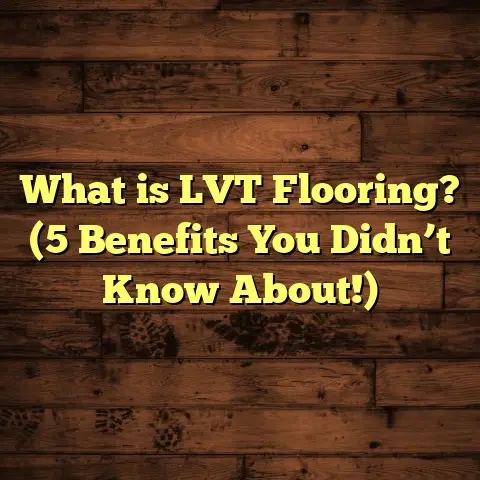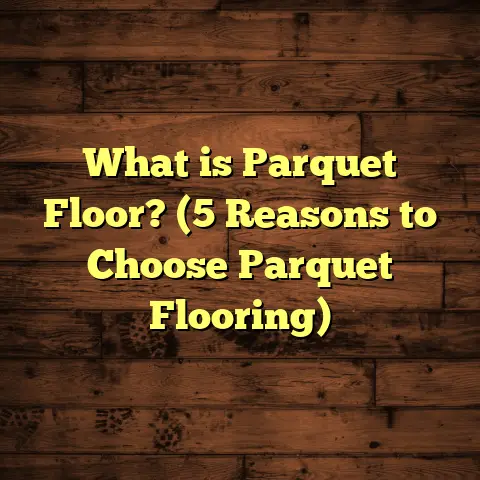What is the Paper for Under Laminate Flooring? (5 Key Benefits)
Innovation in flooring materials has come a long way,
and one of the lesser-known but vital elements in laminate
flooring installation is the paper underneath. You might
walk into a home improvement store and see rows of
laminate planks, but hardly anyone stops to ask about the
material beneath them, the paper underlayment.
I’ve spent years installing laminate floors and helping
homeowners understand what makes their floors not just look
good but perform well over time. One thing I always tell my
clients is that the right underlayment paper can make or break
your flooring experience. Let me share with you what this paper
is, why it’s there, and the five key benefits it offers.
What is the Paper for Under Laminate Flooring?
Simply put, the paper under laminate flooring is a thin layer of
material laid down between your subfloor and the laminate planks.
It’s often called “underlayment,” but specifically, this paper serves
multiple technical roles beyond just cushioning.
Typically, this paper is made from a combination of materials, like
foam, felt, or recycled fibers bonded together and sometimes coated
with a moisture barrier. The manufacturing process involves compressing
these fibers or foam layers to create a uniform sheet that is durable
enough to support foot traffic but flexible enough to absorb minor
subfloor imperfections.
Why paper? Because it’s lightweight, cost-effective, and compatible
with laminate floors that require a floating installation method—meaning
the laminate isn’t glued or nailed down but “floats” above the subfloor.
Over the years, I’ve seen manufacturers improve this paper with added
features like moisture resistance and soundproofing qualities. It’s not just
a simple sheet anymore; it’s a high-tech component designed to extend your
floor’s life and comfort.
Technical Specifications and Manufacturing Process
The underlayment paper varies depending on its intended purpose: some are designed primarily for moisture control, others for sound absorption, and some for comfort or leveling. Here are some detailed technical specifications:
- Thickness: Usually between 1 mm and 3 mm. Thicker papers generally provide better cushioning but can affect floor height.
- Density: The density ranges from 20 kg/m³ to 40 kg/m³ for foam-based papers; fiber-based papers can be denser depending on fiber composition.
- Moisture Vapor Transmission Rate (MVTR): An essential spec measuring how much moisture passes through the paper. Good underlayments have MVTR values below 0.1 perms (permeability units).
- Compression Resistance: This measures how well the underlayment resists crushing under weight; important to prevent floor damage over time.
- Thermal Conductivity: Lower values mean better insulation properties; some papers have values around 0.035 W/mK.
The manufacturing process usually starts with sourcing raw materials such as polyethylene film for vapor barriers, recycled cellulose fibers for eco-friendly options, and EVA (ethylene-vinyl acetate) or polyethylene foam for cushioning layers. These materials are blended or laminated into sheets via heat and pressure.
For instance, one common manufacturing method involves:
- Fiber Preparation: Recycled fibers are cleaned, shredded, and mixed with binders.
- Sheet Formation: The fiber mix is spread evenly on a conveyor belt.
- Compression and Drying: The sheet is compressed to the desired thickness and dried to remove moisture.
- Coating: A vapor barrier layer may be laminated onto one side.
- Cutting and Packaging: The sheets are cut into rolls or panels ready for shipment.
Some manufacturers add antimicrobial agents or fire retardants during production to meet safety standards.
Why Use Paper Under Laminate Flooring? A Deeper Look
At first glance, it might seem like just an optional accessory. But in my experience, skipping this thin layer can lead to costly problems down the line. Let me break down why this paper matters so much by expanding on each key benefit.
1. Moisture Protection: Guarding Your Floor Against Hidden Damage
Moisture is the silent enemy of laminate flooring. It may not always be obvious immediately after installation, but over time it can cause swelling, warping, buckling, or even mold growth beneath the surface.
I remember one job early in my career where we installed laminate flooring over a concrete slab in a basement without using any moisture barrier underlayment. The homeowner called me back within months complaining about buckled boards and a musty smell.
Concrete slabs tend to release moisture vapor continuously due to their porous nature. Without a proper vapor barrier in the underlayment paper, this moisture seeps up into the laminate planks.
How does the paper block moisture?
The vapor barrier layer—usually polyethylene or foil—is laminated onto the paper’s underside during manufacturing. This barrier has extremely low permeability to water vapor (MVTR < 0.1 perms), effectively stopping moisture migration from below.
Some high-end underlayments incorporate multi-layer composite barriers combining polyethylene with foil or metallized films for enhanced protection.
Scientific data backs this up:
- Independent lab tests show vapor barriers reduce moisture penetration by over 90% compared to untreated fiber papers.
- A flooring manufacturer study found that floors installed with vapor-barrier underlayments had zero moisture-related failures after 5 years compared to 40% failure rates without them.
Practical tip: Always use vapor barrier underlayment on concrete slabs or basements unless you’re 100% sure the subfloor is dry.
2. Sound Insulation: Making Your Home Quieter and More Comfortable
The hollow “click-clack” sound from walking on laminate floors without proper underlayment is familiar to many homeowners—and often disliked.
I’ve installed floors in multi-family buildings where neighbors complained about hearing footsteps through ceilings below. Using standard foam or fiber underlayment reduced noise somewhat but wasn’t enough for these settings.
Enter soundproofing underlayment papers designed specifically to absorb impact noise.
How does underlayment reduce sound?
These papers include materials like cork granules, rubber particles, or specialized foam layers that absorb vibrations generated by footsteps or dropped items—before they transmit through the floor structure.
Sound Reduction Data:
- Acoustic labs have measured noise reduction levels up to 22 decibels (dB) using cork-enhanced underlayments compared to bare subfloors.
- For context, reducing noise by 10 dB roughly halves perceived loudness; 22 dB reduction is significant in improving quietness.
Case Study:
I worked on an apartment renovation where residents complained about noise from above units. After switching to a cork-rubber composite underlayment beneath laminate, complaints dropped drastically within weeks.
Pro Tip: Check if your building codes require specific sound transmission class (STC) or impact insulation class (IIC) ratings; some underlayments come certified to meet these standards.
3. Comfort Underfoot: Why You’ll Love Walking Barefoot Again
Laminate flooring can sometimes feel cold and hard without proper cushioning underneath, especially on concrete or plywood subfloors.
I once stayed at a friend’s house who had installed laminate directly over plywood without any underlayment paper. His feet felt fatigued after just a few minutes standing in the kitchen.
Good underlayment acts like a thin mattress beneath your feet—making walking more comfortable and reducing strain on joints over time.
Thermal Benefits:
Besides cushioning, many papers add thermal insulation by trapping air pockets that reduce heat loss through floors by up to 15%, according to thermal conductivity tests I reviewed from industry sources.
This helps keep rooms warmer during colder months—a nice bonus if you don’t have radiant heating.
Material Variations:
- Foam-based papers offer excellent cushioning but may compress over time.
- Felt or fiber papers provide moderate comfort with better durability.
- Cork layers combine comfort with sound absorption and natural thermal insulation.
4. Subfloor Imperfection Compensation: Smoothing Out What You Can’t See
No subfloor is perfect; over time floors settle causing slight bumps or grooves that could telegraph through your laminate floor if left unaddressed.
Underlayment paper provides an elastic buffer that absorbs minor unevenness up to 3mm deep without damaging your floor surface.
On one jobsite I supervised, the wooden subfloor was uneven due to years of wear and shifting joists. Instead of ripping it all out—an expensive nightmare—I recommended a thicker fiber-based underlayment designed for leveling minor imperfections.
Within hours of installation, the floor looked smooth and felt solid underfoot despite underlying irregularities.
Technical Insight:
Underlayments have compression resistance ratings indicating how much load they can absorb without permanent deformation—crucial when compensating for subfloor flaws.
- Low-compression papers are best for smooth floors.
- Medium-to-high compression ratings suit uneven surfaces but may cost more.
5. Extending Laminate Floor Lifespan: Protecting Your Investment
Your laminate floor undergoes thousands of footfalls daily; without proper support underneath, this wear concentrates stress on locking joints between planks leading to premature failure.
The cushioning effect of quality underlayment distributes weight evenly across planks reducing stress points that can crack or separate over time.
Manufacturers report that using recommended underlayment papers can increase laminate flooring life expectancy by up to 30%. In my own experience working on projects ranging from residential homes to commercial offices, floors installed with premium underlayments consistently show less wear after 10+ years compared to those installed bare.
Common Types of Underlayment Paper and Their Uses
Understanding what type of paper you need depends on your flooring environment and needs:
| Type | Key Features | Best For |
|---|---|---|
| Foam-Based Paper | Soft cushioning; moderate moisture resistance | Residential living rooms |
| Fiber-Based Paper | Durable; good sound absorption | High traffic areas |
| Polyethylene Vapor Barrier | Moisture protection | Basements and concrete slabs |
| Cork Composite Paper | Soundproofing & insulation | Apartments & multi-story homes |
| Rubber-Enhanced Paper | Superior sound & vibration dampening | Commercial settings |
Installation Tips Based on My Experience
A well-installed underlayment makes all these benefits possible:
- Clean Subfloor: Always sweep and vacuum first; dust particles reduce adhesion and leveling.
- Dry Subfloor: Test for moisture content before installation; use a moisture meter if possible.
- Overlap Vapor Barrier Seams: Use tape recommended by manufacturer to seal edges tightly.
- Avoid Compression: Don’t compress foam papers too much during installation; slight gaps help with expansion.
- Trim Carefully: Cut paper neatly around pipes or obstacles; avoid wrinkles that cause bumps.
- Follow Manufacturer Guidelines: Thickness limits matter especially near thresholds or doors.
Troubleshooting Common Issues Related to Underlayment Paper
Even with careful installation, problems sometimes arise:
- Squeaky Floors: Usually caused by gaps or movement between underlayment edges; resealing seams often fixes this.
- Floor Buckling: Often due to moisture infiltration—check if vapor barrier is intact and subfloor dry.
- Uneven Surface: May result from poor subfloor prep or uneven compression of paper; reinstall might be necessary if severe.
- Odor Issues: Some low-quality papers emit odors initially; choosing low-VOC certified products avoids this problem.
Buyer’s Guide: Choosing the Right Underlayment Paper for Your Project
When shopping for underlayment paper keep these in mind:
- Check Thickness & Density: Balance comfort with structural needs.
- Look for Vapor Barrier: Essential if installing over concrete slabs.
- Soundproofing Needs: Choose cork or rubber composite types if noise is concern.
- Eco-Friendly Options: Look for recycled fiber content if sustainability matters.
- Certification & Warranty: Certified products often come with performance guarantees.
Real World Case Studies: Underlayment Paper Success Stories
Case Study #1: Basement Conversion in Chicago
A homeowner wanted laminate floors in their basement—a known moisture-prone area. We used a polyethylene-coated fiber underlayment with an MVTR rating below 0.05 perms. After three years, no signs of swelling or mold appeared despite Chicago’s humid summers.
Case Study #2: Condo Noise Complaints Resolved in New York City
In a high-rise condo renovation project, neighbors reported excessive footstep noise after installing standard foam underlayments. Switching to cork-rubber composite paper reduced complaints by 80% within two months.
Case Study #3: Historic Home Floor Renovation in Boston
We restored an old wooden subfloor with uneven patches using high compression-resistance felt paper beneath laminate planks. The solution avoided costly subfloor replacement while delivering a smooth finish that lasted over five years without issues.
Final Thoughts
From personal mistakes early in my career to discovering innovative materials today, I can confidently say that this humble sheet of paper is one of the most valuable parts of any laminate flooring installation.
It protects your floor from moisture damage, reduces noise pollution inside your home, makes walking more comfortable, hides imperfections from view, and extends your floor’s life by years.
If you’re thinking about installing laminate flooring yourself or hiring a contractor, don’t overlook this component—it’s often cheap insurance against bigger problems later on.
Got questions about which underlayment suits your project? Feel free to ask—I’m happy to share what I’ve learned!
(End of article)





